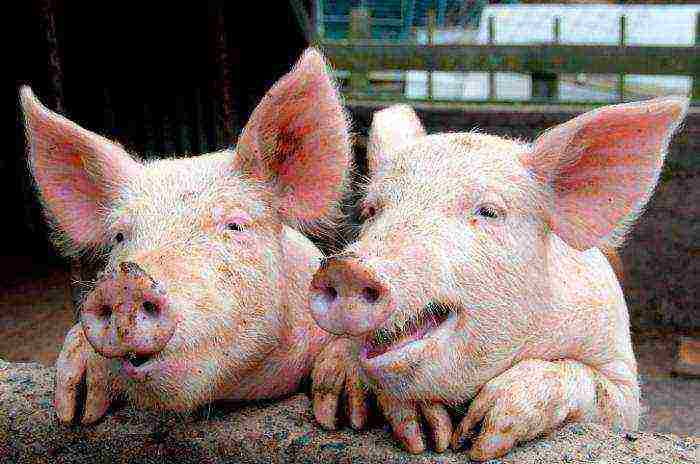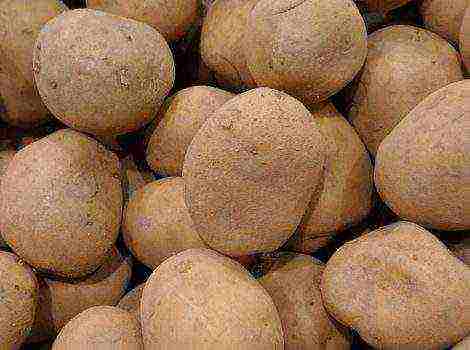Content
- 1 What you need to know
- 2 How to choose a piglet for fattening
- 3 Types of feeding technologies
- 4 Features of the preparation of the diet at different periods of the life of pigs
- 5 Pig fattening
- 6 Features of the method
- 7 Pig fattening
- 8 Simplified diagram
- 9 Supplements
- 10 Frequency of food troughs
- 11 Maintaining the appetite of pigs
- 12 Determination of weight
- 13 Is it profitable to keep pigs and why
- 14 Pig breeding and fattening business
- 15 Correct diet
- 16 Causes and signs of piglet diseases
- 17 A profitable business or a waste of time
Keeping piglets at home is a very profitable business, but quite troublesome. First of all, a correct balanced diet should be developed for the animals. There are several technologies for feeding pigs, which must be known for those who want to achieve good results in this matter.
What you need to know
Fattening of piglets for meat at home is made with the obligatory observance of the following recommendations:
- The stomach of pigs, in contrast to cattle, is single-chambered. Therefore, the basis of their diet should be not coarse, but concentrated feed. Since there is not so much protein in cereals, animals must be fed with oilcakes, special yeast, legumes, skim milk, skim milk and fish meal.
- The size of the portion prepared is determined by how much the raised pigs can eat at one time. The mishmash remaining in the troughs must be thrown out without waiting for it to sour.
- Concentrated feeds for these animals are usually given in crushed form. Whole grains of wheat, barley, oats, etc. are very poorly assimilated by them.
How to choose a piglet for fattening
When buying, first of all, you should pay attention to the development, breed and health of the animal. Good pig:
- has a wide back, long body and strong legs,
- during the run does not choke and does not wheeze,
- does not suck, but eats the offered food with appetite.
How to choose a piglet for fattening, therefore, is not a particularly difficult question. Next, we will consider the actual methods of raising these animals in relation to the diet.
Types of feeding technologies
So, the basis of the diet of these farm animals is grain feed and vegetables. There are only two types of pigs fattening: meat and to fatty conditions. In this article, we will take a closer look at the features of the first technology. She, in turn, is subdivided into two more varieties: actually meat and bacon. Both of these methods can be used to feed all breeds bred in our country.
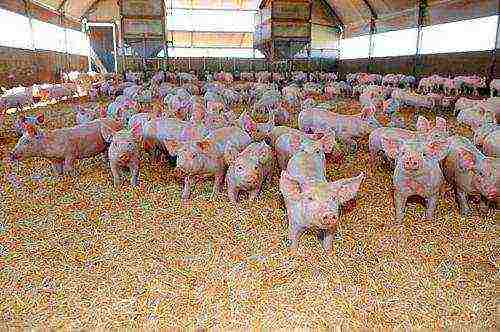
Features of the preparation of the diet at different periods of the life of pigs
The "menu" of pigs largely depends on their age. In this regard, only two growing periods are distinguished:
- Lactic. Depending on the age at which the pig was purchased, this period can last from three to four months. At this time, the animal is fed very often (5-6 times a day) and little by little. Up to four weeks of age, the basis of the piglet's diet is cow's milk. At the end of this period, the animal is transferred to the removed one. Cereals are usually given in mixed form. Also in the diet of little pigs include boiled potatoes and carrots.
- The actual fattening. This period begins after the animals reach a weight of about 20 kg (as a rule, this is about 2.5-3 months of age).
Pig fattening
This technology is used most often in our country.When using it, it is possible to grow pigs with very tasty tender and juicy meat, with a layer of bacon on the ridge of 2.5-4 cm, which is in high demand among the population. Piglets start feeding at home using this technology when they reach a weight of 25 kg (at the age of about 3 months). Finish - by 6-8 months. By this time, the weight of pigs reaches about 90-120 kg.
Features of the method
Fattening piglets for meat at home using this technology is divided into two main periods. Before reaching a weight of 70 kg, the pigs undergo an intensive growth of muscle mass. At this time, the lion's share of the diet of animals - in addition to grains and potatoes - should be food rich in protein. This can be, for example, peas, green mass of legumes, reverse, fishmeal, etc. After reaching a weight of 70 kg, the amount of crushed grain and juicy feed is increased in the pigs ration. In both of these periods, animals must be given 10-35 g of salt per head per day and 5-25 g of chalk.
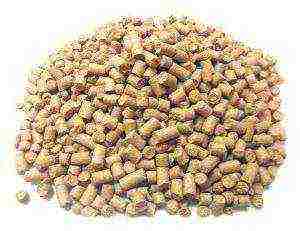
Pig fattening
This method is a form of meat technology. Its difference is, first of all, that with its use it is possible to grow animals with very high quality bacon meat, which has always been subject to increased requirements. Using this method, you can get pigs weighing 80-105 kg. It is mainly applied only to animals of special early maturing bacon breeds. Like the conventional meat method, this technology is divided into two main periods. Up to 5.5 months, pigs are fed so that the gain in live weight is about 400 g per day. Next, I develop the menu in such a way that this figure increases to about 600 g.
The ration of bacon-fed piglets consists of such feeds as barley, vetch, peas and other legumes, millet, as well as various animal additives. Particular attention is paid to the compilation of the menu in the second period. At this time, such deteriorating properties of feed meat as fish waste, oilcakes, soybeans, etc., are completely excluded from the pigs' diet.
Simplified diagram
Fattening piglets for meat at home using the technologies described above allows you to end up with a very high-quality product. However, their maintenance costs, in the case of the development of some special diet, is quite expensive. Therefore, very often the owners of household plots feed pigs according to a simplified scheme, choosing one of its two options: dry or wet. In this case, you can also get a fairly high quality meat.
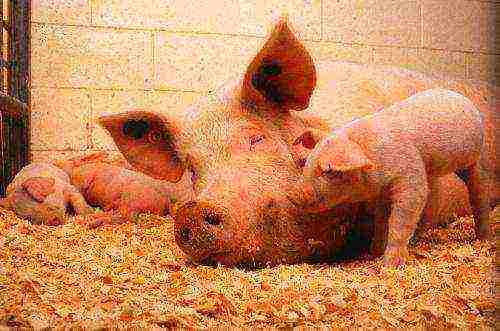
When choosing a wet feeding technology, the pigs ration consists mainly of mash. They are prepared from boiled potatoes, vegetables, food waste and herbs. Also, the pigs are given crushed grain. At the same time, pea flour, vitamin and mineral supplements, cake are mixed with it.
Dry feeding is technologically simpler than wet feeding. Indeed, in this case, you do not have to cook vegetables and carry heavy buckets of mash. In addition, it is fast fattening of piglets and very efficient. However, dry technology, in comparison with wet, has some disadvantages. Pigs raised in this way, for example, are more likely to be constipated. Since they receive food only in dry form, it is necessary to ensure that the animals always have fresh water in the drinkers. When using this method, pigs are given mainly cereal mixtures. Cultivation using this technology is, of course, more expensive than using the wet method.
Supplements
It is possible to reduce the costs of keeping pigs by using special mixtures. Fattening of piglets on dietary supplements, among other things, improves the quality of meat. Basically, such preparations are a mixture of various vitamins, as well as macro- and microelements. The amino acids contained in them significantly increase the digestibility of the feed.
Frequency of food troughs
So now you know how to raise fattening piglets for quality meat.Next, let's see how many times a day it costs to fill animal troughs with food. Suckling pigs, as mentioned above, are given food 5-6 times a day. Juvenile pigs under 4 months of age are filled with troughs three times a day. Later, if the amount of cereals in the diet of young animals reaches 1.5 kg per head, they switch to two meals a day. With the predominance of mash in the menu, three meals a day are retained.
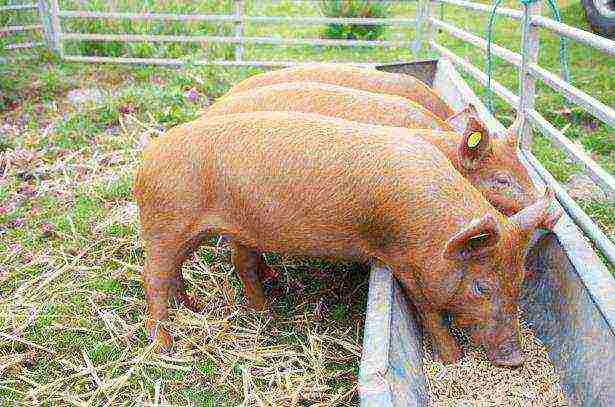
Maintaining the appetite of pigs
In order for the animals to eat better and, accordingly, gain weight faster, feed should be prepared. Usually, such additional measures are taken when fattening pigs. But in some situations, these techniques can be useful when raising animals for meat. Before feeding, for example, cereals, they are subjected to a malting procedure. It consists in pre-soaking concentrated feed with hot water (85-90 degrees) for about 4 hours. In this case, about 1.5-2 liters of liquid are taken per kilogram of grain.
In the event that the pigs do not eat the mash, the leftovers can be poured with pre-prepared oat milk. The feed improved in this way is liked by the pigs much more than usual.
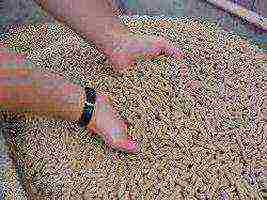
To prepare such milk, one kilogram of oatmeal is poured with boiled cooled water and mixed. The chatterbox should stand in a warm room for about three hours.
Determination of weight
In order to determine the weight gain of a pig over a particular period of time, of course, the easiest way is to weigh the animal. However, unfortunately, it is not always possible to carry out this procedure at home. Therefore, private owners in private farms most often determine the weight gain approximately - using measurements of the chest girth and body length. In both cases, use a measuring tape. When measuring the girth of the chest, it is placed along a vertical line passing along the rear angles of the shoulder blades. Finding out the length of the torso is also easy. To do this, the tape is pulled from the middle of the back of the head along the upper line of the neck, back and sacrum to the root of the tail.
Fattening piglets for meat at home using any of the technologies described above allows you to achieve good results in live weight gain and excellent quality of the final product. With these methods, large pigs can be raised as quickly as possible.
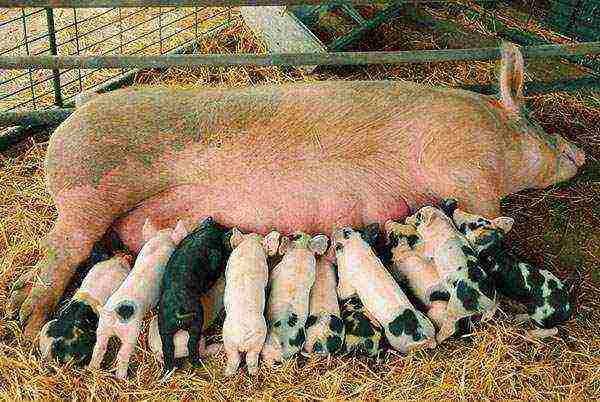 The peasant farm provides the family with food products of plant and animal origin. Pig farming is beneficial for many reasons. Getting meat after short-term fattening, disposal of food residues, summer keeping with grazing makes pork a cheap and affordable product.
The peasant farm provides the family with food products of plant and animal origin. Pig farming is beneficial for many reasons. Getting meat after short-term fattening, disposal of food residues, summer keeping with grazing makes pork a cheap and affordable product.
Is it profitable to keep pigs and why
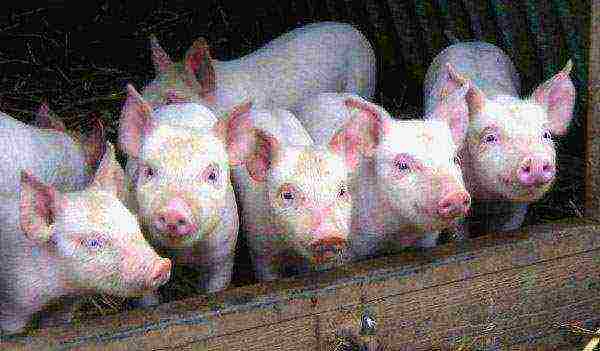 Pork production is beneficial for both the family and business development. In any economic situation, there will be a piece of meat on the table. With a small investment, you can start a pig breeding business on your own backyard. A unique animal will provide a stable income both when raising livestock for meat, and when keeping sows to sell offspring.
Pork production is beneficial for both the family and business development. In any economic situation, there will be a piece of meat on the table. With a small investment, you can start a pig breeding business on your own backyard. A unique animal will provide a stable income both when raising livestock for meat, and when keeping sows to sell offspring.
Objective data on the efficiency of pig keeping:
- a rapid increase in the marketable weight, for a year of keeping the live weight of a newborn piglet increases 140 times;
- carcass weight compared to live weight is 85%, while in cattle it is 50-60%;
- for farrowing, the uterus brings up to 14 piglets, depending on the breed, each of which will bring $ 100-200 in a month;
- pigs assimilate up to 30% of the composition of the feed, in other domestic animals this figure does not exceed 20%.
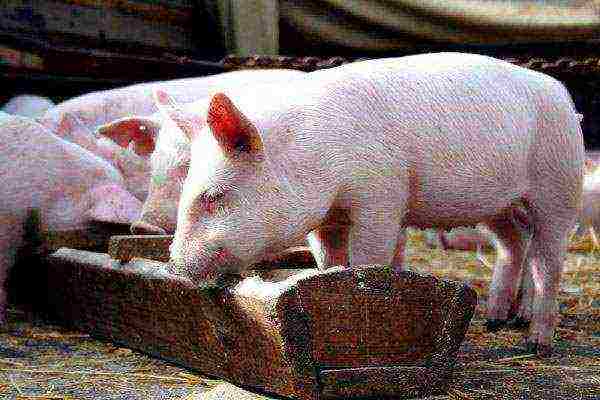 The correct choice of breed and small investment will allow beginners to breed pigs at home to create a successful business. To meet the family's need for meat and lard, it is enough to buy two piglets in early spring. Toddlers don't need a lot of storage space. In the summer, animals grow rapidly.With the onset of autumn, there are many plant residues in the courtyard, which are a good forage base. For intensive feeding of pigs for two months before slaughter, it will be necessary to increase the consumption of protein feed. Aside from the labor of caring for the pigs, a year's supply of pork is cheap. You don't need a warm pigsty. But there are requirements for fattening pigs that must be met.
The correct choice of breed and small investment will allow beginners to breed pigs at home to create a successful business. To meet the family's need for meat and lard, it is enough to buy two piglets in early spring. Toddlers don't need a lot of storage space. In the summer, animals grow rapidly.With the onset of autumn, there are many plant residues in the courtyard, which are a good forage base. For intensive feeding of pigs for two months before slaughter, it will be necessary to increase the consumption of protein feed. Aside from the labor of caring for the pigs, a year's supply of pork is cheap. You don't need a warm pigsty. But there are requirements for fattening pigs that must be met.
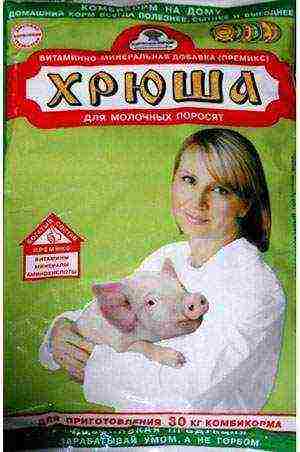 Keeping pigs at home requires proper nutritional choices. So a baby at the age of a month needs:
Keeping pigs at home requires proper nutritional choices. So a baby at the age of a month needs:
- the predominance of dairy products and cereals based on milk or its substitutes;
- the use of special premixes for piglets containing special sets of vitamins and antibiotics, so that the babies grow up healthy;
- maintain a feeding frequency appropriate for the age and stomach size of the piglet.
When fattening a piglet from 2 to 4 months, do not include raw potatoes in the diet, only mashed potatoes or a jerk. Root vegetables are best served boiled and chopped. It is more useful to feed carrots raw grated, the grass should be finely chopped and boiled with boiling water.
After slaughter, the pig carcass is treated with a blowtorch to remove the bristles. A high pressure washer will help wash off the carbon deposits. A compact car wash is available from car owners. The use of this processing method increases the presentation of the product.
Pig breeding and fattening business
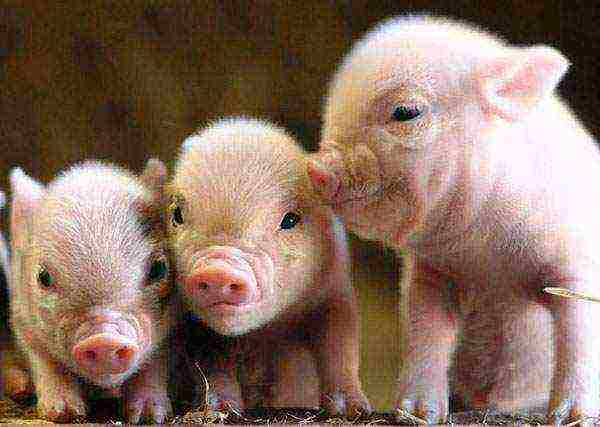 Any business requires planning. A pig breeding business plan should include an expenditure and revenue side. Pig breeding is profitable only if the requirements for the conditions of keeping and feeding the animals are met.
Any business requires planning. A pig breeding business plan should include an expenditure and revenue side. Pig breeding is profitable only if the requirements for the conditions of keeping and feeding the animals are met.
Therefore, the main item in the cost estimate is the construction of a pigsty based on an area of 4 sq. m per feed unit and 6 squares per sow. The room should include a den, a walking area and a canopy from the sun. A bathhouse should be provided for the pigs. If feeding is done in a shared trough, there should be enough room for each animal to approach.
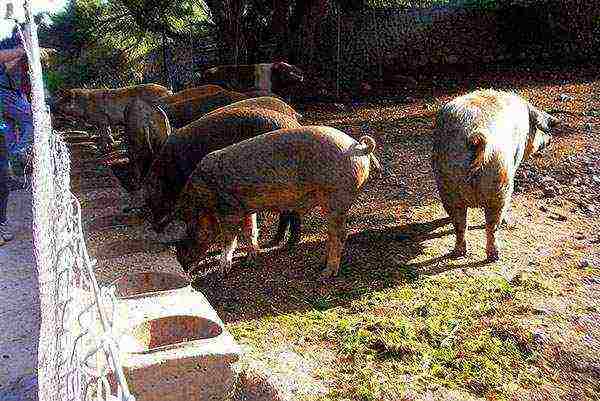 The stable must be strong so that the pig does not go into the wild as a result of the digging. Provide in the pigsty:
The stable must be strong so that the pig does not go into the wild as a result of the digging. Provide in the pigsty:
- roof, excluding leakage;
- natural and combined lighting;
- capital walls, excluding freezing;
- floor with waste gutters and clean, dry underlay;
- ventilation of the room.
When placed, there should be a walking area, on which pigs spend most of their time in the summer. In the open air, muscle gain is faster, animals get sick less.
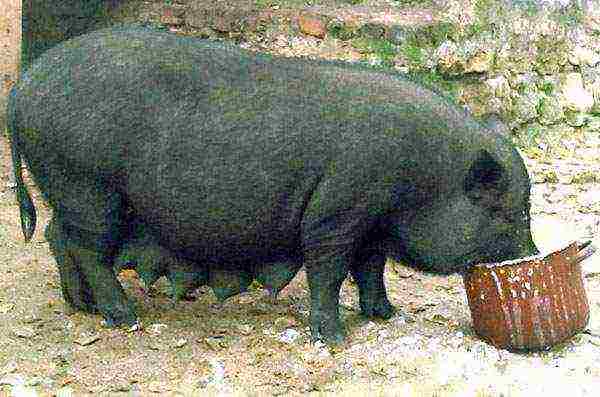 The expenditure part includes the acquisition of thoroughbred individuals. For commercial production of meat, the breeding of pigs of the desired breed must be carried out on the farm. This will reduce the cost of purchasing piglets on the outside and allow you to get healthy offspring for the herd.
The expenditure part includes the acquisition of thoroughbred individuals. For commercial production of meat, the breeding of pigs of the desired breed must be carried out on the farm. This will reduce the cost of purchasing piglets on the outside and allow you to get healthy offspring for the herd.
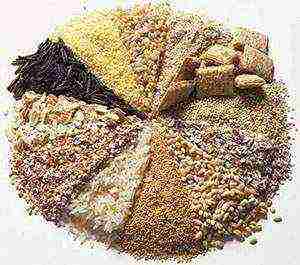 If piglets are purchased from other farms, they must be quarantined before the herd is formed. It is necessary to budget for the vaccination of the herd at each stage of development. Without a certificate of veterinary control of the livestock, the legal sale of meat will be impossible.
If piglets are purchased from other farms, they must be quarantined before the herd is formed. It is necessary to budget for the vaccination of the herd at each stage of development. Without a certificate of veterinary control of the livestock, the legal sale of meat will be impossible.
The current cost item will be the purchase of special feed for pigs, premixes and vitamin complexes. However, feed is much cheaper than meat. The cost of production is traditionally high. And if the growing technology is observed, the business risk is minimized, but this cost item needs to be planned.
With a large number of pigs, dry feeding is preferable. The increased feed costs will pay off with a greater weight gain and lower costs for fattening. At the same time, it is important to provide animals with water at 6-8 liters per head per day.
The income part takes into account that one sow can give up to 14 piglets, whose fattening will provide up to 3 tons of marketable products. Distribute profits by the timing of product receipt.If the resulting balance does not give the expected profit, the business plan for breeding pigs needs to be optimized. That is, find cheaper feed or suckers. Successful pig breeders in a backyard receive up to 1000% of the profit in 2-3 years.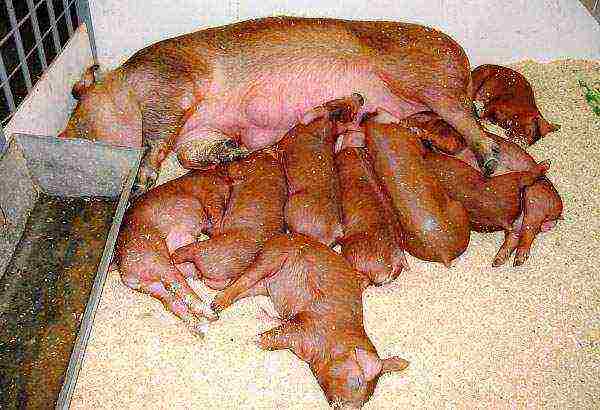
In order for raising pigs at home, as a business, to be successful, the following rules should be followed:
- observe hygienic conditions for keeping pigs;
- do not miss the time for the castration of pigs;
- to carry out preventive measures against diseases and avitaminosis of the livestock;
- observe the time and frequency of feeding animals, ensure constant access to water.
It is impossible to feed feed with mold and signs of acidification of liquid feed. Feeders should be periodically treated with boiling water.
When buying offspring from thoroughbred pigs, you need to know about the structural features of animals. You can get pork with a predominance of lard, bacon or meat from a particular breed.
 Is it profitable to keep pigs? There is no other way to provide a family with meat at cost. To organize a business with a small number of heads, the sale of meat will take place without going to trading floors. Neighbors will become buyers. Livestock products are always in steady demand.
Is it profitable to keep pigs? There is no other way to provide a family with meat at cost. To organize a business with a small number of heads, the sale of meat will take place without going to trading floors. Neighbors will become buyers. Livestock products are always in steady demand.
Agricultural revolution - video
Part 1
Part 2

Content:
- Correct diet
- Causes and signs of piglet diseases
- A profitable business or a waste of time
Regardless of the breed, raising piglets at home goes through several stages:
- Farrowing and suckling period. The duration of this stage is approximately four weeks: from birth and feeding exclusively on breast milk until weaning from the sow.
- The period of weaning from breast milk and the mother in general. This stage passes in about 7-10 days, when the piglets begin to stay with the sow exclusively for feeding her milk.
- The final period is piglet feeding. There are different types of feeding depending on the goals set, i.e. meat, bacon and greasy.
- The purpose of fattening is to obtain young and juicy pork in 6-8 months.
- Bacon feeding is more time consuming and more expensive, which produces pork that is in high demand for bacon cooking.
- Piglets are fattened to greasy conditions to obtain selected lard from pork carcasses.
For raising and keeping piglets, certain conditions are necessary: a room, a specially designated place for feeding, a place for walking, temperature regime, vaccinations, timely treatment, and so on.
Piglets are raised in small herds, preferably of the same age, sex, weight and physiological state. Pigs of different breeds tolerate stresses in different ways, both natural (heat, cold, pressure drops) and technological (transportation, vaccination, drug treatment).
To achieve good results (selected pork) when raising boars at home, it is necessary to castrate them at the age of one month. In order to fully develop and grow rapidly, young animals need to walk both in winter and in summer. Compliance with zoohygienic standards in pigsties leads to the receipt of selected pigs and, consequently, to material benefits.
Correct diet
Sows, boars and young animals should be fed with different food, taking into account their characteristics. The digestive system of pigs is formed in the first days of their life, so feeding of piglets should be taken under control from the very moment of their birth. In order to avoid diarrhea, constipation and other problems with the gastrointestinal tract, together with breast milk, the piglet needs feeding.
Table of approximate feeding of young animals
| Warm water | from the 3rd day |
| Cow's milk, mineral supplements, concentrates, premixes | from the 5th day |
| Porridge | from the 8th day |
| Bean hay and dust | 10th day |
| Juicy feed: | |
| carrot | 10th day |
| beet | 20th day |
| potatoes | 25th day |
| Green grass | 12-15 days |
| Hay infusion | 30th day |
Piglets should be fed frequently and at regular intervals.Most of the feed ingredients for pigs can be grown at home (vegetables, herbs, grains), which in itself will reduce the cost of the feed needed. To water, however, as well as to feed, young animals follow from a special container intended for this. For the diet of young animals, iron-containing preparations are of particular importance. They can be given to piglets with feed or by injection, which is easy to do at home. Premixes are used to enrich the piglets' diet.
Causes and signs of piglet diseases
General characteristics
Raising healthy piglets is the key to high productivity of the future pig population. Their diseases are always easier to prevent than to treat them later. Therefore, the success of the pig business lies in the timely prevention of diseases, the creation of decent conditions for keeping and feeding animals (premixes, vitamin complexes, etc.).
Piglet diseases can be divided into:
- Non-communicable diseases (anemia (anemia), gastroenteritis, dyspepsia, bronchitis, etc.).
- Infectious diseases (edema of piglets, plague, foot and mouth disease, dysentery, paratyphoid fever, etc.)
Common signs of disease in pigs include loss of appetite, increase / decrease in body temperature, rash, spots, dry skin, depression / agitation, diarrhea and other symptoms. Small pigs are more susceptible to many ailments than their adult relatives, which must be taken into account when raising them.
The main causes of the disease of piglets are improper feeding (abuse of premixes, concentrates), lack of vitamins and nutrients in food, non-observance of temperature and zoohygienic standards. The cost of all the above shortcomings of the pig farmer is a decrease in the profitability of the business as a whole.
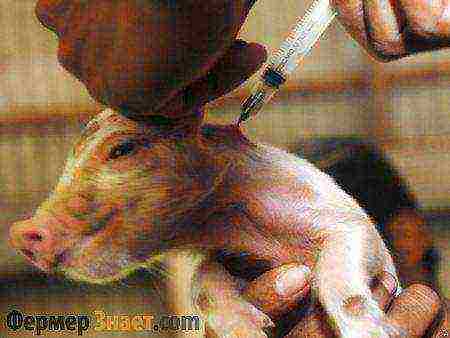
Types of diseases and their manifestations
Gastroenteritis, dyspepsia, acute gastrointestinal inflammation and poisoning are diseases of the digestive system. Signs of their appearance are diarrhea, lethargy, lack of appetite, convulsions and vomiting. In order to avoid these ailments when raising young animals, you need to feed the piglets with fresh food grown at home.
Pig catarrhal diseases (bronchitis, tracheitis, bronchopneumonia) are manifested by coughing, fever, and rapid breathing.
Disturbed metabolism causes such diseases in the piglet as alimentary anemia, rickets, vitamin deficiency, etc.
Infectious diseases of piglets affect their health and the health of the rest of the livestock more destructively than others. They require more radical methods of their treatment and elimination of the consequences.
Swelling disease of piglets occurs due to intoxication of the body with bacteria or food allergies. With it, the nervous system is affected and swelling of tissues and organs appears. Piglets of weaning age are exposed to this ailment. Growing young at home without a sow initially (with a “stranger” mother) usually eliminates the possibility of this disease.
Swine fever is the most dangerous disease caused by tiny microorganisms.

Dysentery is detrimental to piglets in that they rarely recover. A distinctive feature of this ailment is diarrhea with blood, which is accompanied by constant attempts.
Another deadly disease that piglets are prone to is foot and mouth disease. It is accompanied by high fever, watery blisters in various parts of the body, which, when bursting, turn into ulcers. As a result, the acute form of foot and mouth disease leads to the death of animals. When raising pigs, this ailment is a significant expense for the owner.
Most diseases require urgent professional care, so you should not neglect the services of a veterinarian who will provide the necessary treatment, otherwise its cost will significantly exceed the funds spent on prevention.
A profitable business or a waste of time
The well-known misconception that pig farming is the most profitable and easiest business can be quickly dispelled by any farmer involved in breeding and raising piglets. To get good results (income), you need to create the best conditions. Growing piglets at home brings a good income if they are raised in clean pigsties, eat good rational feed with premixes and biologically active substances, and are vaccinated on time.
In terms of ROI, this business is a good place to start, as you can start with a small number of pigs and build momentum over time. Young piglets (their meat, fat and skins) can be sold at a good price from 4 months of age. This is due to the physiological characteristics of pigs, namely their rapid growth, omnivorousness, high slaughter yield and distinctive qualities of meat.
Subsequently, the breeding of domestic piglets can be turned into a highly profitable business, if you follow certain rules:
- The choice of the breed should be determined by the desired goals.
- The selection and purchase of females and males should be carried out from different suppliers, paying due attention to the pedigree characteristics of the animals.
- Keeping a pigsty at a decent level (timely disinfection, destruction of pests, temperature regime).
- Close supervision of a veterinarian for regular vaccinations, prevention and treatment of infectious diseases.
- Compliance with the peculiarities of feeding sows, boars and young piglets. They should be fed with high-quality, rational and nutritious feed (using premixes, biologically active substances, etc.).
With the above rules in mind, it is possible to turn pig breeding into a truly profitable production, not just a home business.

Are you tired of constantly buying expensive and not always high-quality meat in the market or in the store, and raising pigs on your own seems more and more attractive idea? If on your site there is a place for a pigsty, and you yourself are ready to devote time to breeding pigs, the only thing left to do is to determine for yourself whether the game is worth the candle?
What conditions are necessary for keeping pigs?
Raising pigs is considered one of the most successful animal husbandry options, profitable and relatively easy. A sow twice a year brings about ten piglets, which grow very quickly, gaining weight well on a small amount of feed. Neither poultry nor cattle will provide such an effective growth. However, you should not count on the fact that the pig can be kept in any conditions and fed with whatever it is necessary. Although these animals are omnivorous, their health and quality of meat largely depends on the diet.
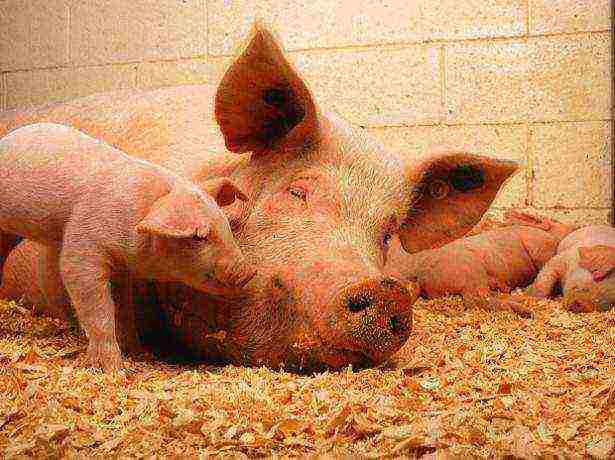
Raising pigs is considered almost the most successful option for animal husbandry, profitable and relatively easy.
If the idea of taking up pig breeding captivated you seriously, first you should familiarize yourself with the basic rules of how to raise pigs and study the characteristics of different breeds. For example, some common breeds of large white pigs are of the bacon type, and no matter how hard you try, you won't be able to get good lard from them.
But small-looking, pot-bellied Vietnamese pigs can provide you with the most delicate meat with a small layer of bacon and, in addition, will not cause much trouble in care. Therefore, it is worthwhile to first weigh all the pros and cons of different breeds, and choose the breed that best suits your goals.
Pig breeding video
So, you have decided on the desired breed of pigs, but before you go after the piglets, take care of creating optimal conditions for their maintenance. The best option would be a fairly spacious barn, divided into three parts: a room with stalls for the constant keeping of animals, a walking area with a canopy and a specially dug bathing pit.
The pens, in turn, consist of a den and a feeding area. For fattening young animals, a pen area of 3 sq.m. is suitable, for a pregnant uterus - 4 sq.m., and for a lactating sow up to 6 sq.m.
When planning to raise pigs at home, take into account that these animals, due to the peculiarities of their physique, are able to use the slightest omissions in the construction, breaking insufficiently strong fences, partitions and making undermines. Therefore, it is worth taking special care of the strength of the pigsty. In addition, in the pig room, provide:
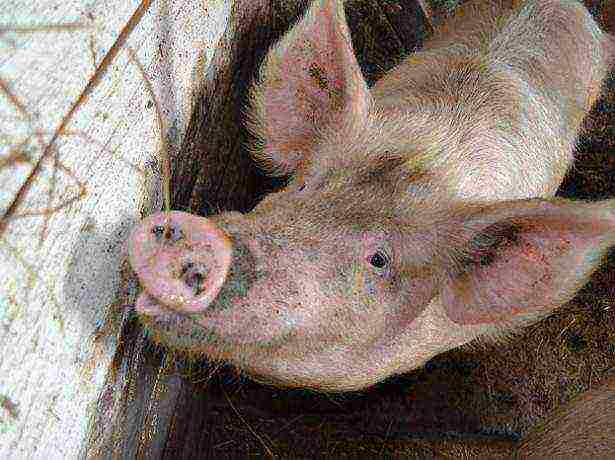
Make sure to create optimal conditions for piglets before you go to pick them up.
- warm waterproof roof;
- dense non-freezing walls;
- warm hard floor with gutters to remove excrement;
- optimal lighting;
- ventilation;
- heating devices, especially for the pen with newborn pigs.
When building a pigsty, materials are used that retain heat well: brick, adobe, cinder blocks, shell rock (reinforced concrete is not suitable). From the inside, the walls are plastered and whitewashed for sanitary and hygienic reasons. The floor is recommended to be made of planks so that it is durable and warm. It is imperative to provide a slope of the floor for the drainage of water and urine. The machines are assembled from metal or wood.
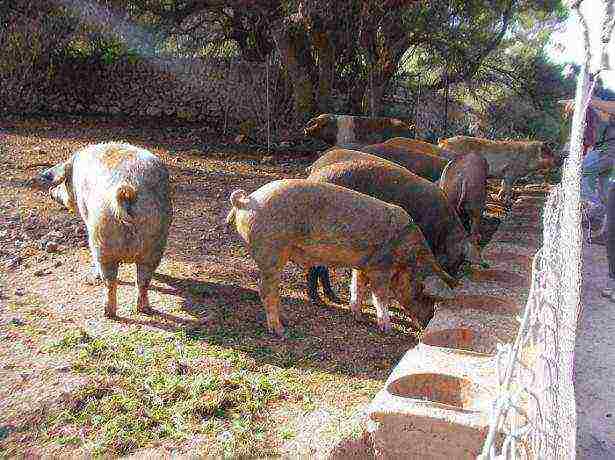
The drinker in the pen is installed at a low elevation so that animals do not pollute the water
The area of the walking area for pigs must be at least ten square meters. The drinker in the pen is installed at a low elevation so that the animals do not pollute the water.
Insemination of sows and raising piglets
For pig breeding, you can either regularly buy 6-8 week old piglets, or raise your own sows, which will produce two litters per year. But be prepared that the first offspring will have to wait no less than a year later, since maturity in pigs occurs after 8 months, and the gestation period lasts about 115 days.
A mating pig should weigh at least 100 kg by eight months, be healthy, free from defects and have 12 well-defined teats. A few days before mating, she is transferred to a more nutritious diet with juicy feed, concentrates, skim milk and kitchen waste, so that the pig will add 0.5 kg per day (no longer desirable).
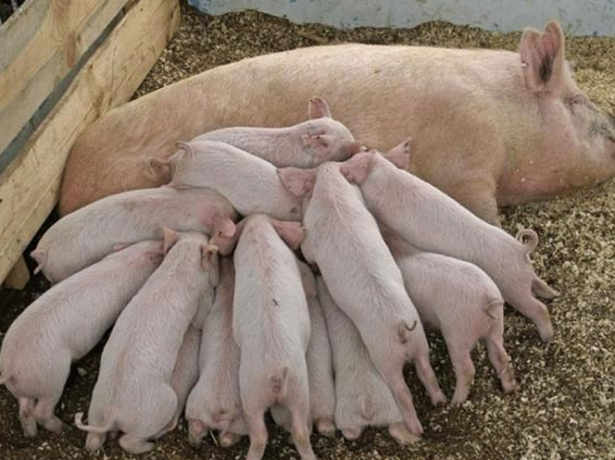
A mating pig must weigh at least 100 kg by eight months
From the moment of the onset of sexual heat, which is easy to determine by the restless behavior of the animal, a kind of grunting and a reflex of immobility, the mumps after 12 hours happen to a boar, or they are inseminated artificially. After another 12 hours, mating is repeated, and over the next seventeen days, carefully monitor whether the sow has again appeared signs of heat. If not, then the pig was fertilized, otherwise the mating is carried out with another boar.
The pregnant pig is fed for the first three months, as before, and only from the second half of pregnancy do they begin to give more concentrated feed. It is important not to allow moldy, rotten, frozen foods to enter the feed in order to prevent the death of embryos.
Piglets are born very weak, so raising them with or without a sow is a very responsible business. Success is determined by suitable conditions of detention (temperature not lower than +18 degrees, no dampness and drafts, good lighting), as well as feed. Sow's milk not only provides piglets with immunity against various diseases, but is also a valuable food product, due to which babies can quickly gain weight in three weeks of the suckling period.
After that, the intensity of growth already depends on the piglets' feeding on various feedings. From the fifth day after birth, piglets are given skim milk, then steamed concentrates in the form of cereals, and from the 20th day, mashed root vegetables are added.Piglets are weaned from sows at the age of four weeks.
When growing piglets without a sow, they are fed warm cow or goat milk from a bottle with a nipple, accustoming them to feeding from the second week.
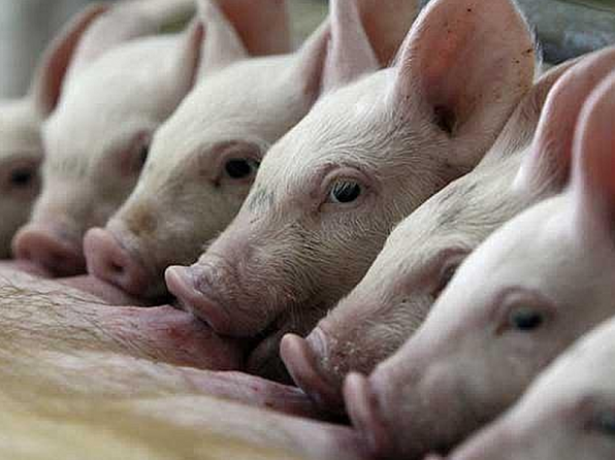
When raising piglets without a sow, they are fed warm cow or goat milk from a bottle with a teat
Small piglets have a very high risk of developing anemia, from which they begin to lag behind in growth, lose weight and die. In order to prevent iron deficiency, animals are injected intramuscularly with iron-containing preparations or iron sulfate is added to drinking water - for one pig, a teaspoon of solution (2.5 g of vitriol per liter of water).
How to feed and how to feed pigs
Growing pigs is convenient because you can grow the bulk of the feed for them on your plot: carrots, pumpkins, sugar and fodder beets, potatoes, peas, alfalfa, etc. And from wild plants, you can prepare nettles, the most valuable for pigs.
When buying small pigs, it is recommended to feed them three times a day with boiled root vegetables with a small addition of crushed wheat and plant food (legumes or nettle scalded with boiling water) with whey. About two to three kilograms of feed should go to one pig per day. Additionally, 10 g of salt should be given to the animals every day.
Piglets need even more water than adult pigs - up to four liters a day. Moreover, the water in the trough should be changed two or three times a day to avoid contamination and infection with infectious diseases.
Pig breeding and keeping videos
Features of pigs feeding according to age:
- Piglets are fed from the age of three months. Since they need more protein for the active formation of muscle mass, boiled legumes, chopped cabbage leaves, boiled carrots, coarsely grated are added to the diet. The feed volume is increased to 4 kg per animal.
- By the seventh month of life in a pig, the ratio of muscle mass to fat begins to change, the growth of animals almost stops. The daily ration rate during this period should be about 6 kg, food is enriched with boiled sugar beets, the amount of salt consumed daily increases to 30 g.
- From eight months, the pig has been fattening up lard, so peas and boiled corn, chopped zucchini, pumpkin and fatty waste should predominate in the diet from this time on. Fresh and cooked fruits will produce more tender, lean meat. The amount of daily feed for an eight-month-old pig should reach 7 kg, and the amount of salt should be 40 g.
- By the first year, in a well-fed pig, the ratio of meat to fat should be 60:40, with a weight of 250 kg. The amount of feed consumed per day is increased to 8 kg.
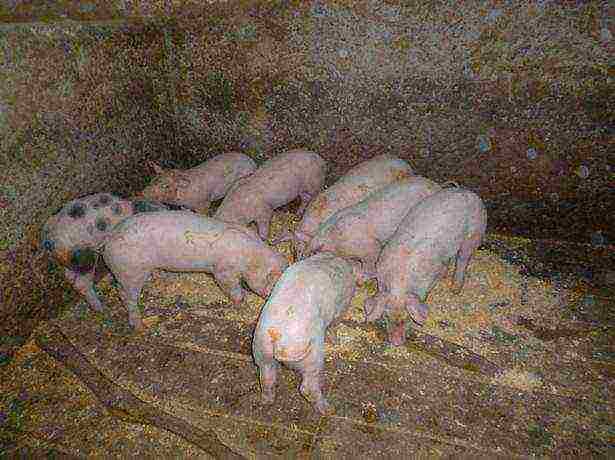
Piglets are fed from the age of three months
You can read more about the features of feeding pigs in the corresponding article on our website. If, with a full-fledged nutrition of the pigs, you cannot feed them, perhaps the animals simply do not have enough movement to gain muscle mass - give them a larger aviary.
Rate the article:
(12 votes, average: 3.6 out of 5)
